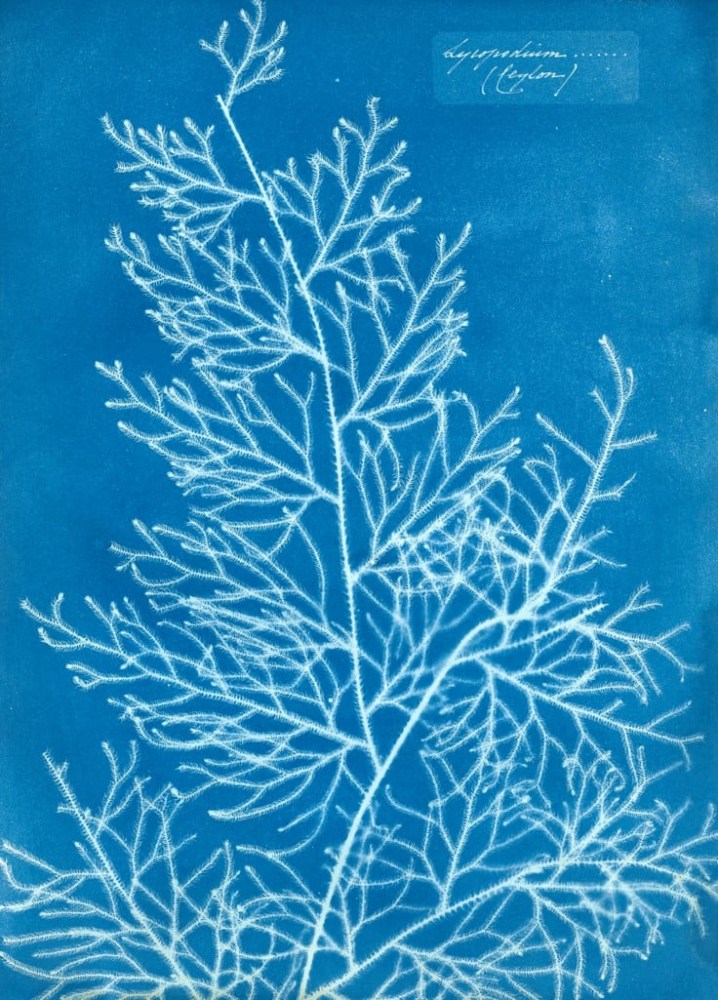
Anna Atkins (English, 1799-1871)
"Lycopodium (Ceylon)," circa 1851-1854
Cyanotype photogram
35.1 x 25.0 cm
After Anna Atkins, one of the earliest women photographers, produced British Algae, the first published book printed and illustrated with photography, she turned her love of the photogram toward the production of images for sheer visual pleasure. Her cyanotypes of the 1850s are striking precursors of the expressive photography of twentieth-century and contemporary artists. Fellow botanists frequently gave Atkins specimens from their travels.
Inquire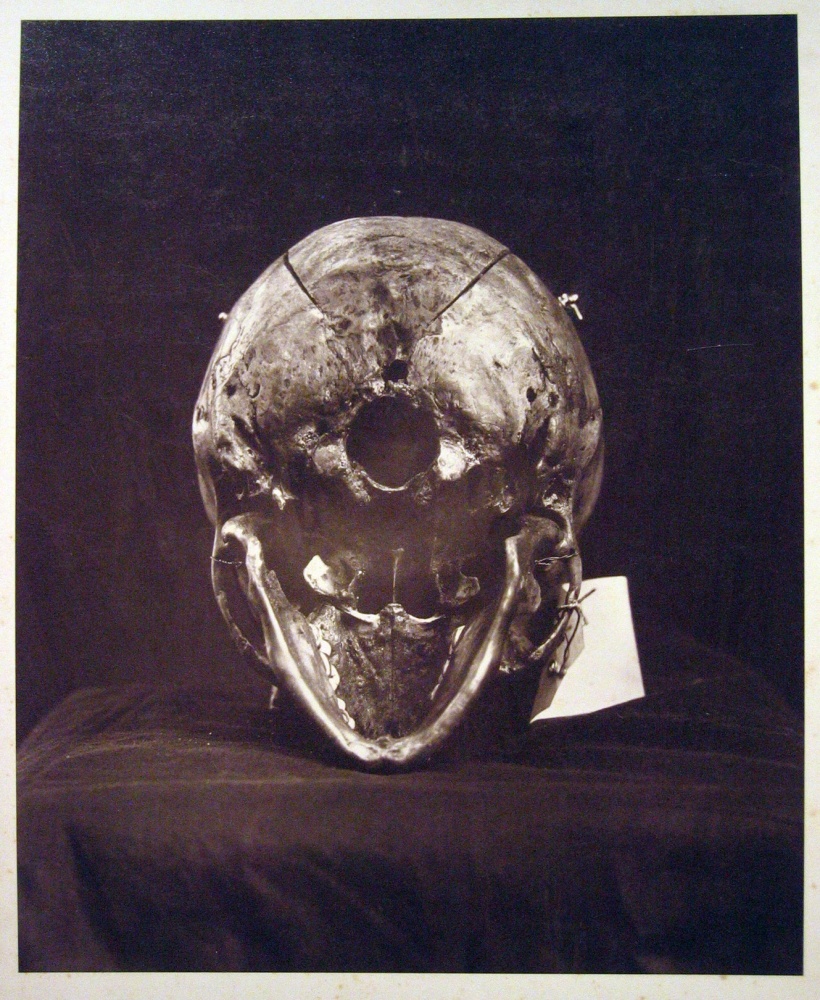
Belgian Judiciary Service
The Peltzer Case, skull of M. Bernays as evidence, circa 1882
Carbon print
31.7 x 25.9 cm
At the trial, evidence surrounding the gunshot wound to the head was important in establishing the cause of death and whether it could have been a suicide or an accident.
Inquire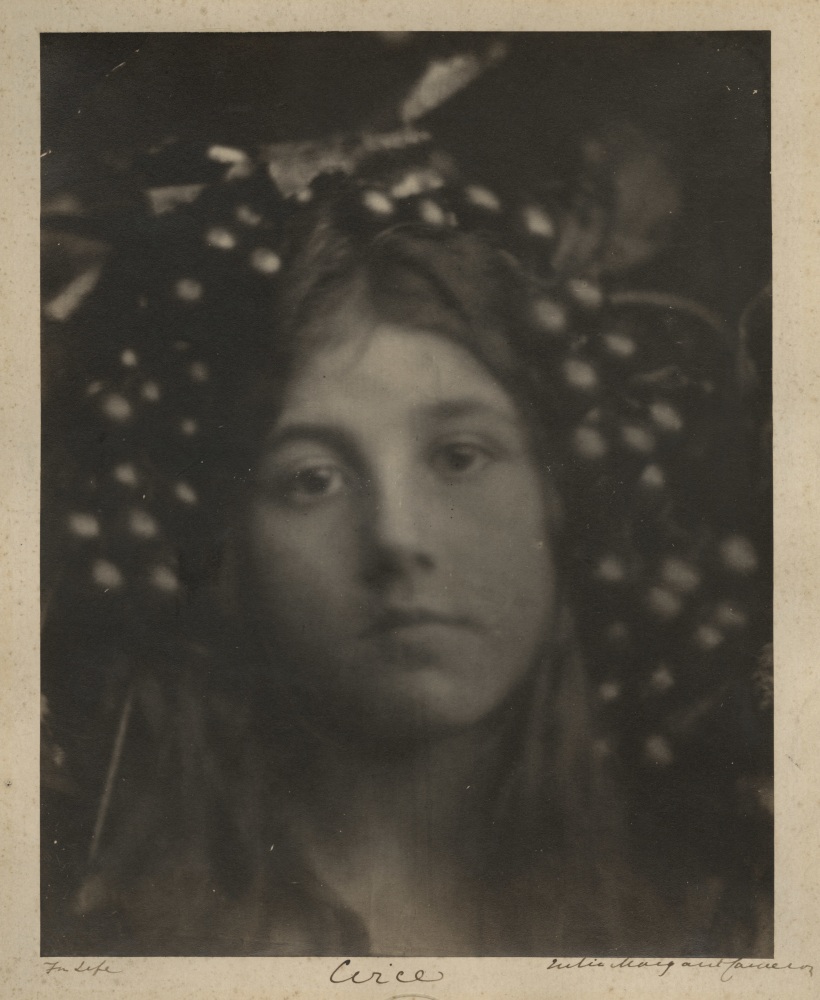
Julia Margaret Cameron (English, born in India, 1815-1879)
"Circe," Kate Keown, 1865
Albumen print
25.2 x 20.2 cm
Cameron sought to record through the faces of her family and friends the qualities of innocence, wisdom, piety, or passion ascribed to great biblical, historical, and legendary figures. Cameron used a long exposure and shallow depth of field to give that slight sense of animation which merges the young girl, Kate Keown, with the mythic character Circe, seemingly bringing her into the viewer's presence in this fine print.
Inquire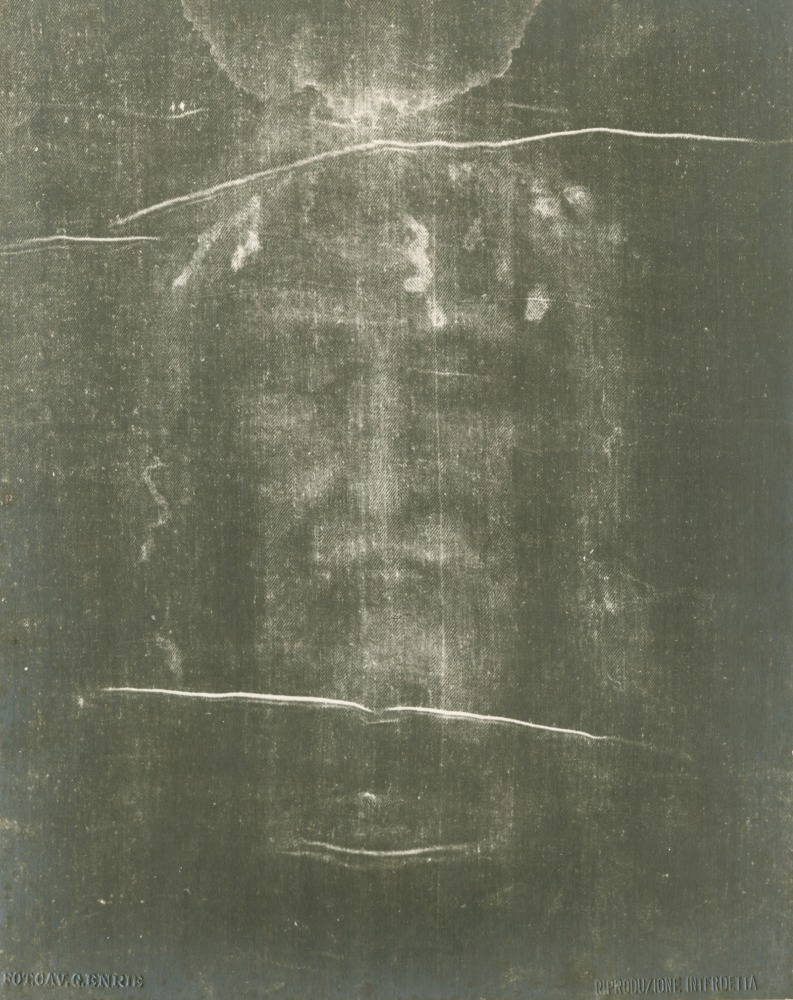
Giuseppe Enrie (Italian, 1886-1961)
Shroud of Turin, 1931
Gelatin silver print
29.0 x 23.0 cm
In May 1931 the Shroud’s owner, King Victor Emmanuel 3rd of Savoye, agreed to have a new series of photographs made on the occasion of an exhibition of the Shroud held that year. The photographer who would make these photographs was Giuseppe Enrie, a professional photographer. The last time photographs had been taken was in 1898 when Secondo Pia had made the famous series showing that the image on the Shroud was like a photographic negative which then set in motion scientific interest in the Shroud. There had been great advances in photographic technologies since Pia's time, and Enrie was given the opportunity to photograph the complete Shroud in three sections, making a series of life-size close-ups of the face, the back and the shoulders, and the bloodstain on the wrist area of the left arm.
Inquire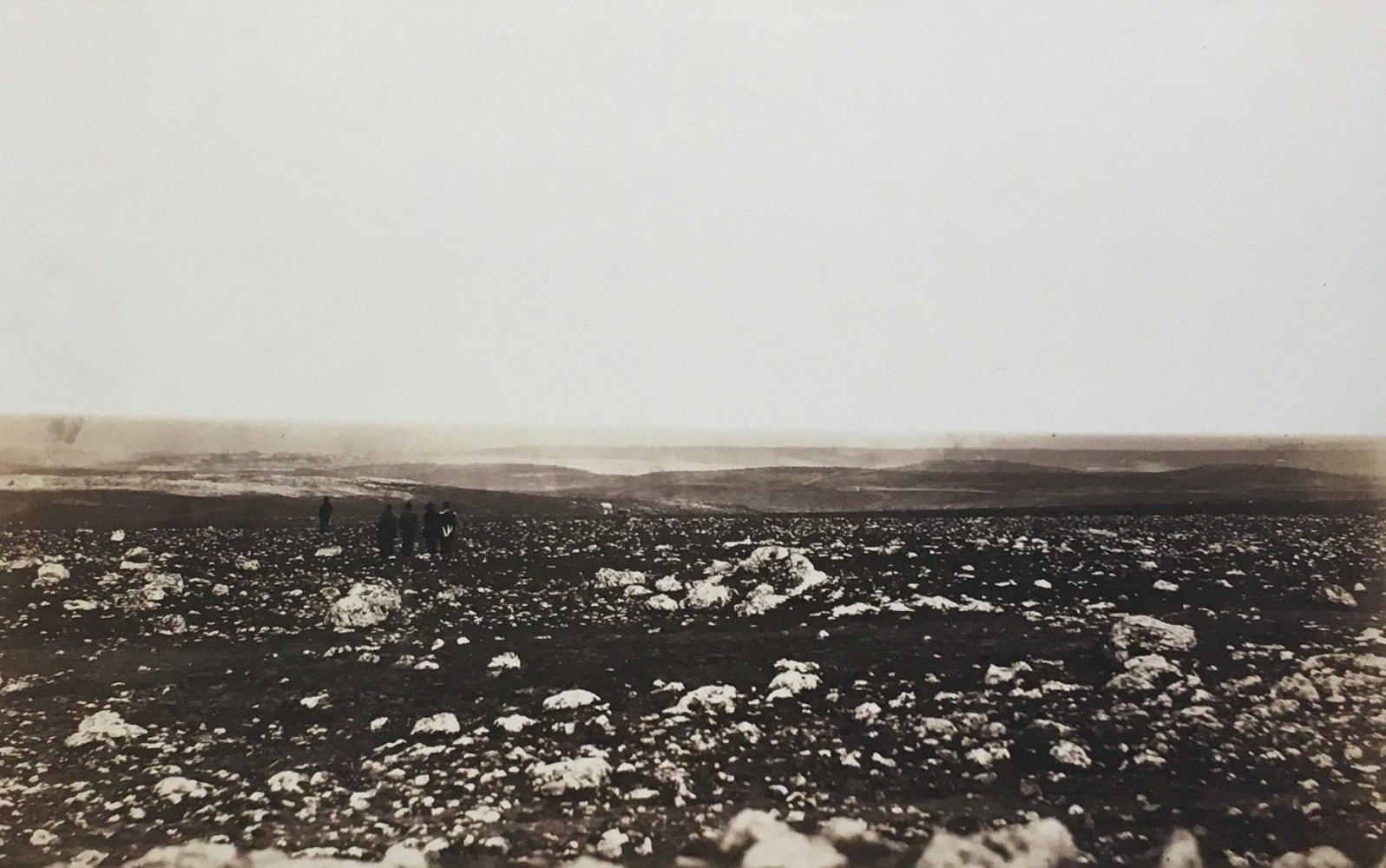
Roger Fenton (English, 1819-1869)
Sebastopol from Cathcart's Hill, Crimea, 1855
Salt print from a collodion negative
22.7 x 35.9 cm
In this nearly abstract composition, Fenton focuses his lens on the middle-ground to show the officers looking out over the harbor at Sebastopol. Fenton masked out the sky before or during the printing process.
Inquire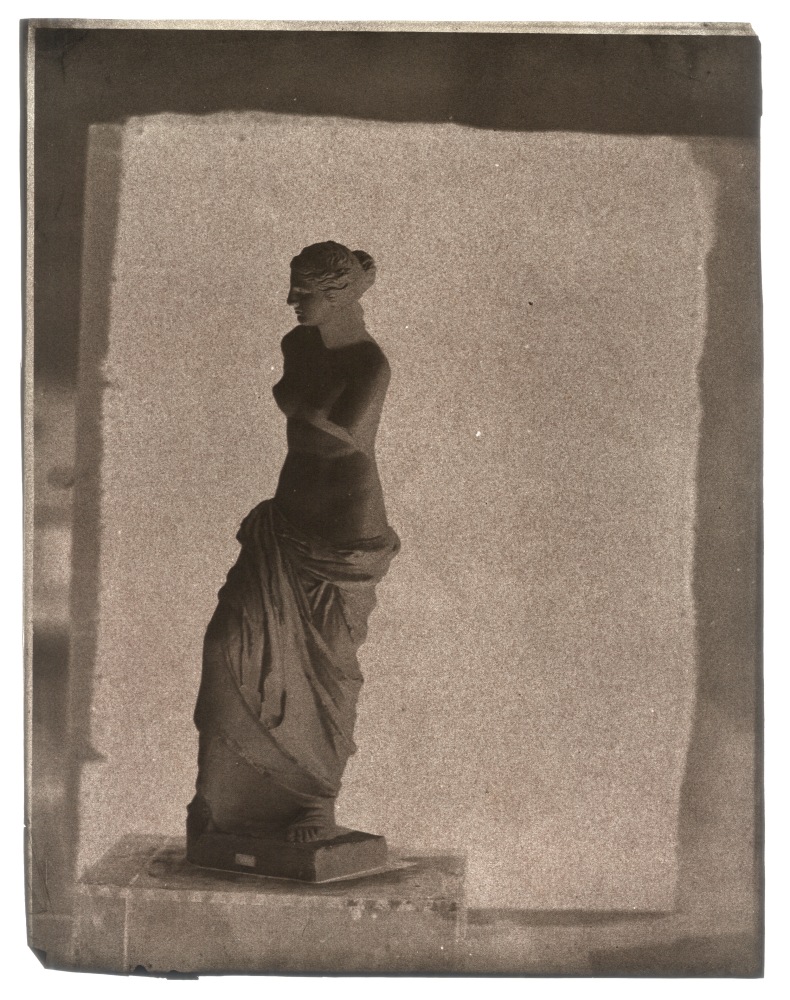
John Beasley Greene (American, born in France, 1832-1856)
Venus de Milo on rooftop in Paris, 1852-1853
Waxed paper negative
31.2 x 24.3 cm
Greene's rooftop images of vegetables and the plaster cast of the Venus de Milo were made during his formative period as a student of Gustave Le Gray in Paris. Greene, perhaps in collaboration with Le Gray, carried his statuette of Venus to the roof in order to sharpen his skills in lighting and composition.
Inquire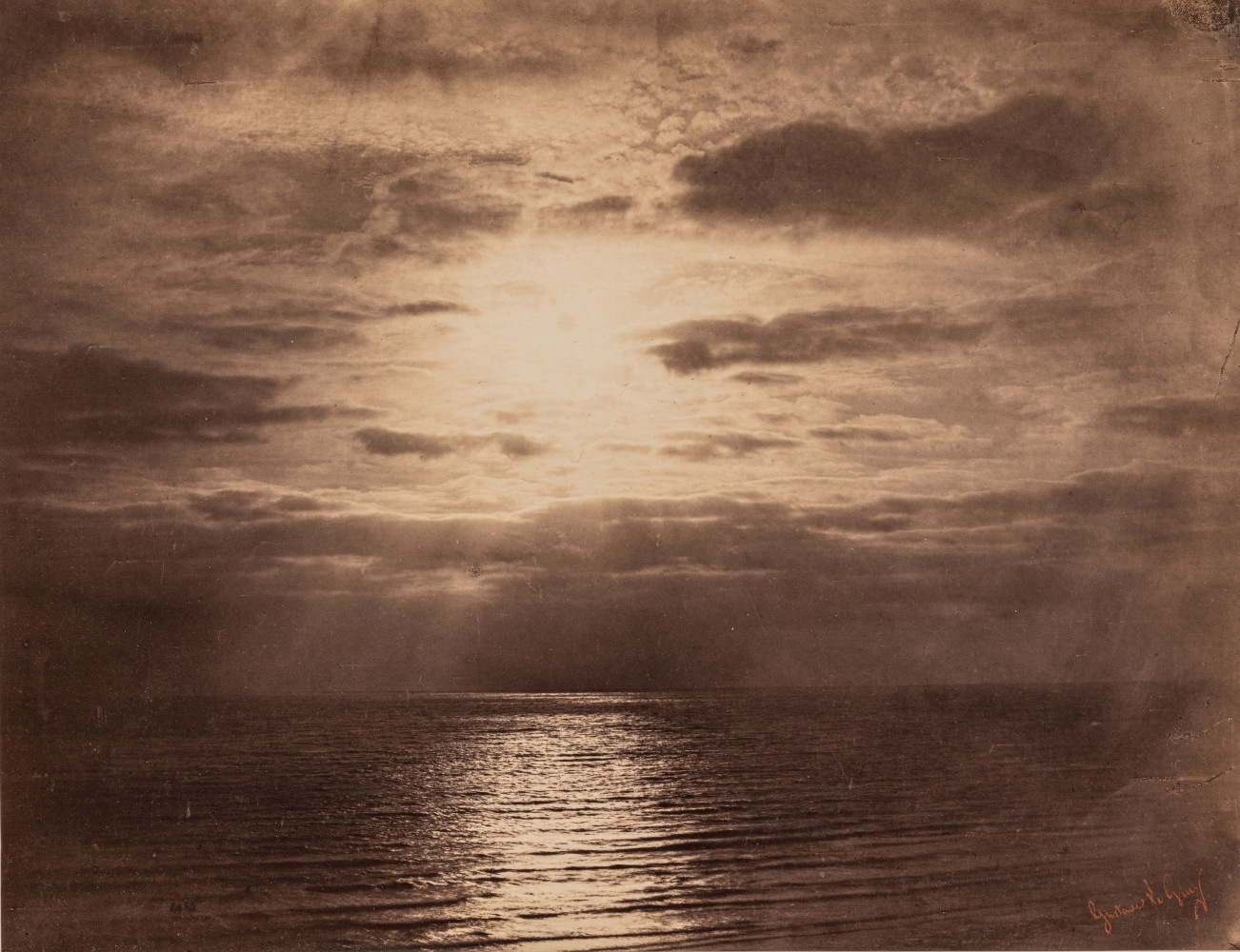
Gustave Le Gray (French, 1820-1884)
Ocean, solar effect in the clouds, 1856
Albumen print from a collodion negative
31.0 x 40.4 cm
One in a series of poetic and meditative seascapes that brought Le Gray international acclaim for their technical and artistic achievement, this print demonstrates his mastery of the medium with a tour de force combination of clouds, empty seas and sun. The seascapes Le Gray created between 1856 and 1858 are the works for which he is most celebrated.
Inquire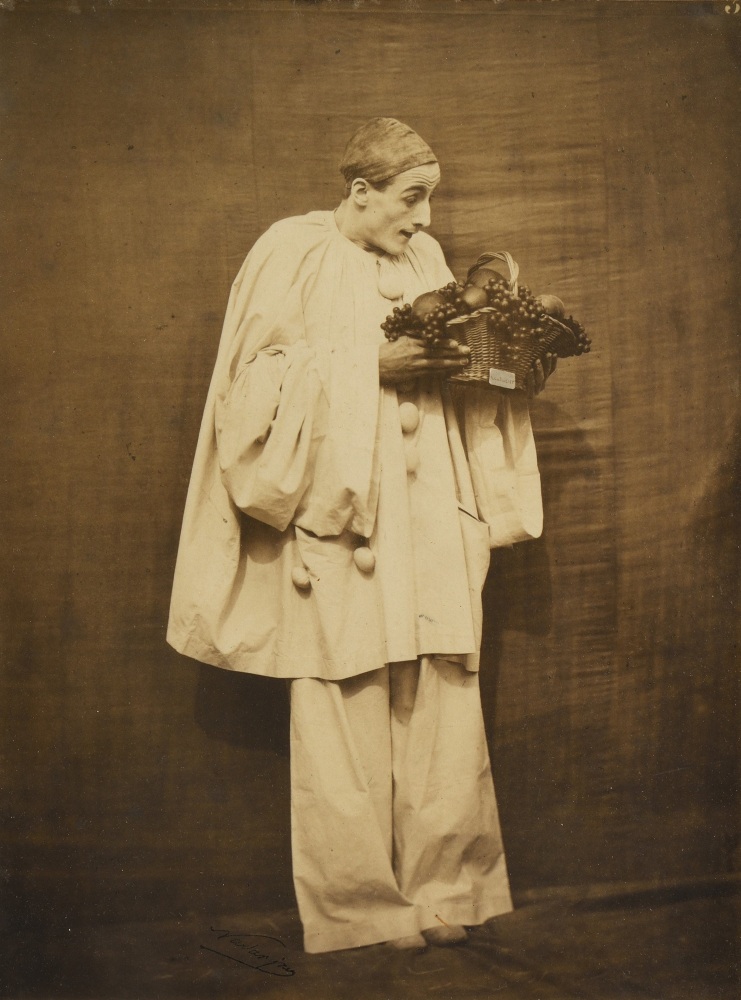
NADAR (Gaspard-Félix Tournachon) and Adrien Tournachon
(French, 1820-1910 and 1825-1903)
Pierrot with fruit, 1854-1855
Gelatin coated salt print (vernis-cuir)
28.0 x 20.9 cm
In 1854-1855, Jean-Charles Duburau was asked by Nadar and his brother Adrien to pose for a series of photographs of expressions and comical misadventures of the pantomime character Pierrot. They were intended as publicity for the brothers’ struggling studio. The photographs were an enormous popular success and won the gold medal at the Exposition Universelle of 1855 in Paris. This print was part of the group exhibited at the Exposition Universelle of 1855.
Inquire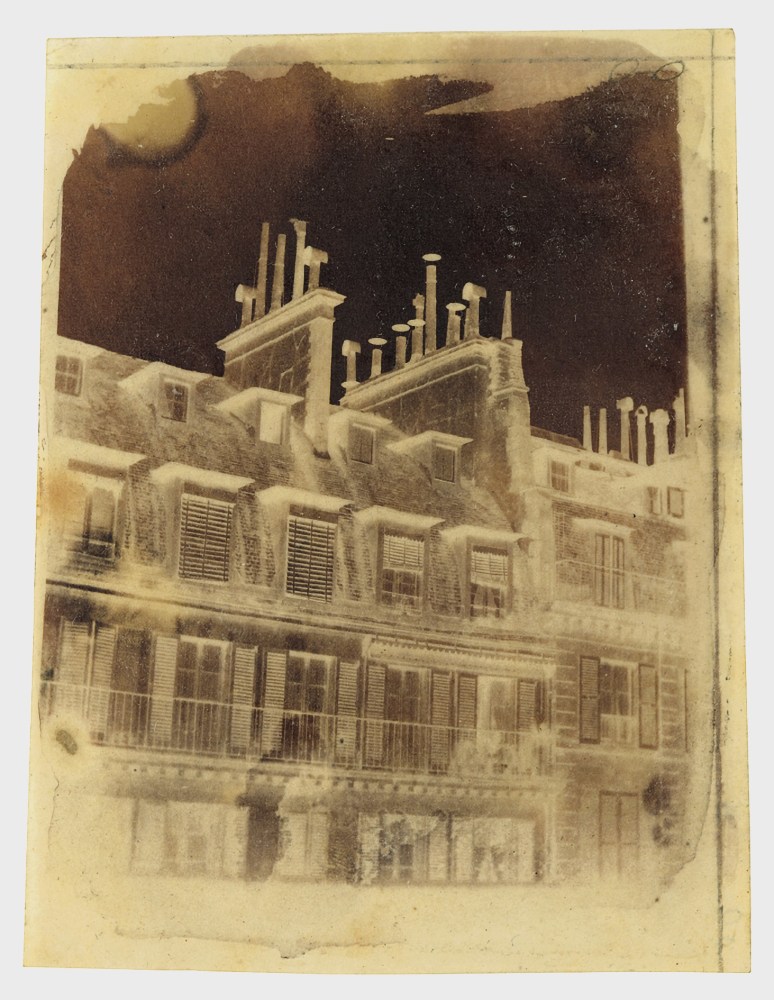
William Henry Fox Talbot or Rev. Calvert Richard Jones
(English, 1800-1877 & Welsh, 1802-1877)
View from a window, rue de la Paix, Paris, 1843-1844
Calotype negative, waxed
10.8 x 8.3 cm
Off of the Place Vendôme in the 2nd arrondissement of Paris, the Rue de la Paix is best known today for its fine shops. In the 19th century, it hosted many small hotels, and through the window of one of these, this view was taken.
Inquire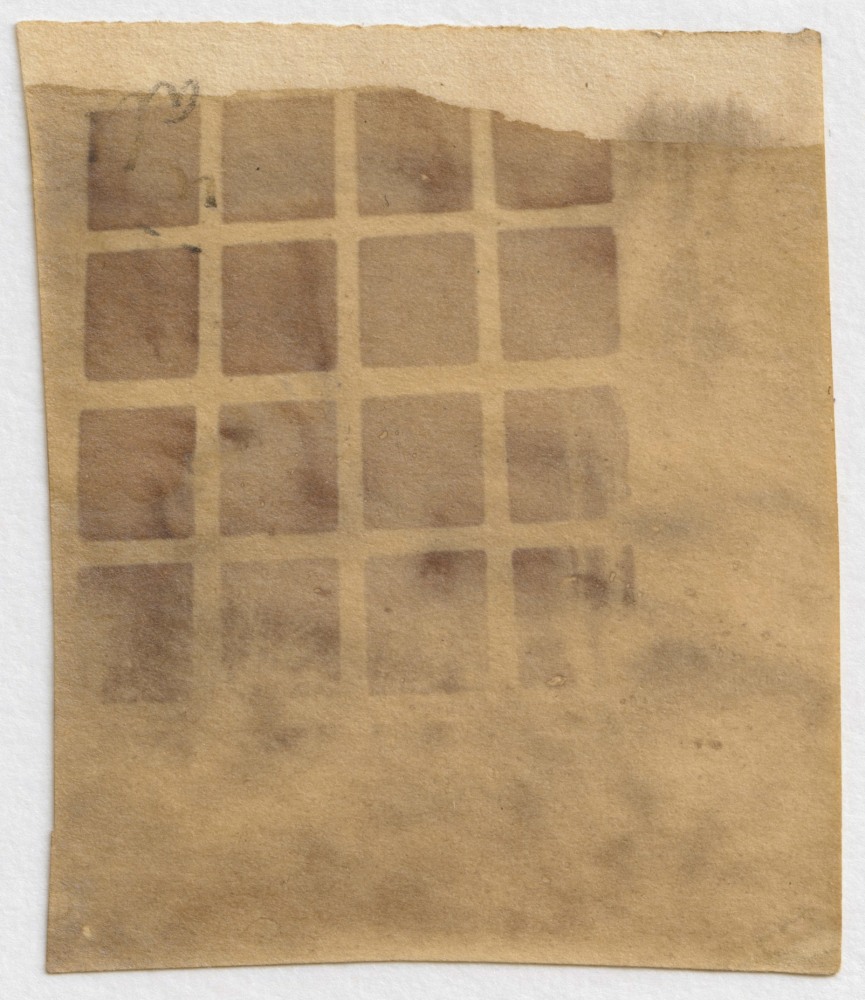
William Henry Fox Talbot (English, 1800-1877)
Lacock woodyard through lattice window, circa 1839-1840
Photogenic drawing mousetrap camera negative
4.3 x 3.6 cm
A view through a window of his home was the first subject on which Talbot focused his camera. It is a concept he addressed on a number of occasions during the earliest years of photography. Square mullions were likely in the Lacock workroom windows in the north range of the Tudor courtyard, facing out into the woodyard. The woodyard is the only place that could have been viewed from the room from which this image was taken. According to Roger Watson, former Curator of the Fox Talbot Museum, these types of windows are no longer extant, but they certainly may have been there in the 1840s. It is not clear if they are glazed windows or bars allowing ventilation. The rooms along this range were all used for storage, tack for the horses, groundskeepers tools etc. They were generally small dark rooms illuminated by a window facing the courtyard and a window facing the woodyard. No print from this negative is recorded.
Inquire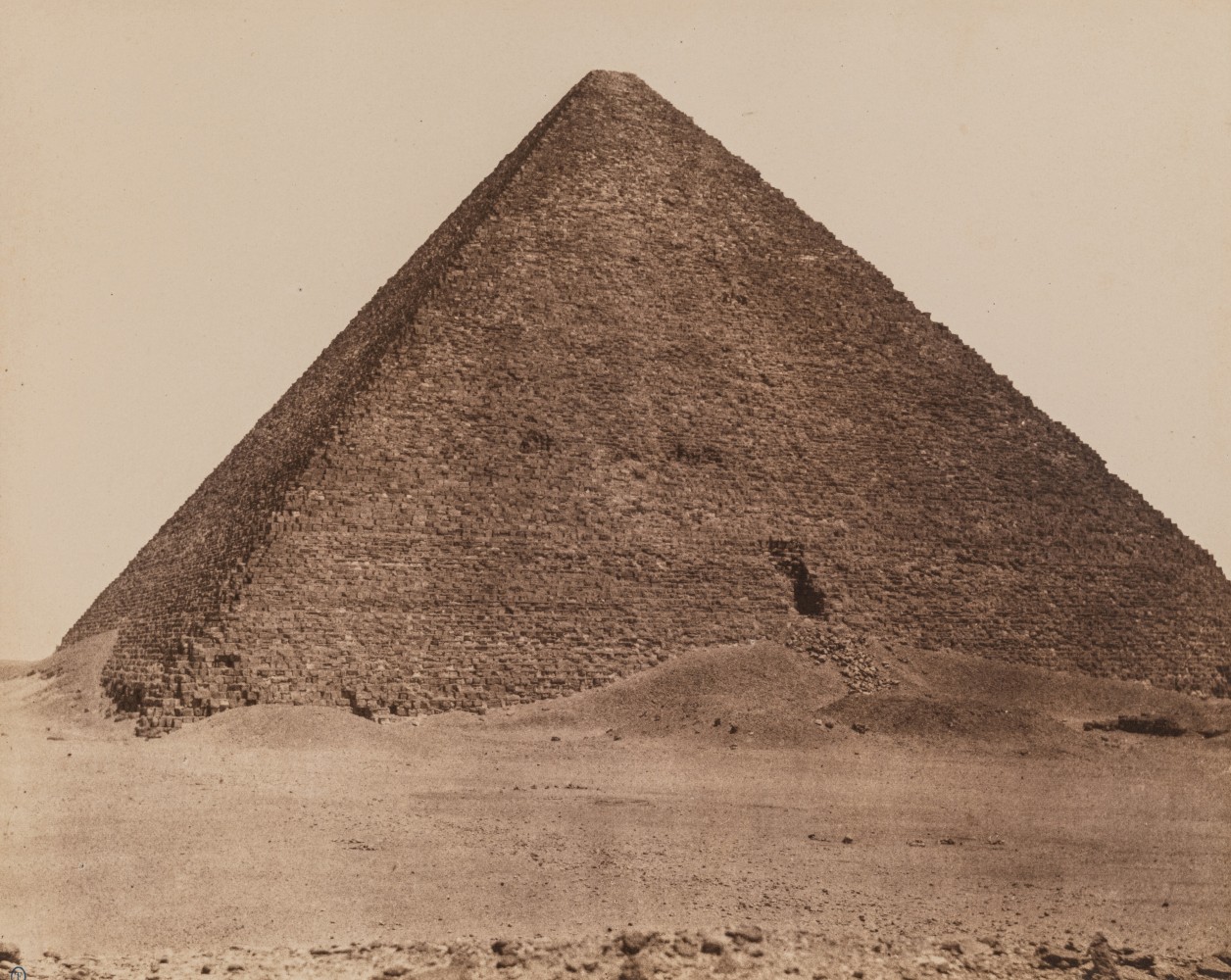
Félix Teynard (French, 1817-1892)
"Égypte / Djïzeh (Necropole de Memphis) / Pyramide de Chéops (Grande Pyramide)," 1851-1852
Salt print, 1853-1854, from a paper negative
24.5 x 30.7 cm
Félix Teynard was one of the first visitors to Egypt to record its monuments and landscape in photographs. A civil engineer from Grenoble, who may have learned the waxed paper negative process from Le Gray, he traveled on an extended voyage to photograph the architecture and landscape of Egypt and Nubia in 1851-1852. Teynard’s 160 images constituted the most complete photographic record to date of the Nile Valley from Cairo to the Second Cataract. These were printed by the Paris firm of Fonteny in 1853-1854 and published by Goupil in 1858.
Inquire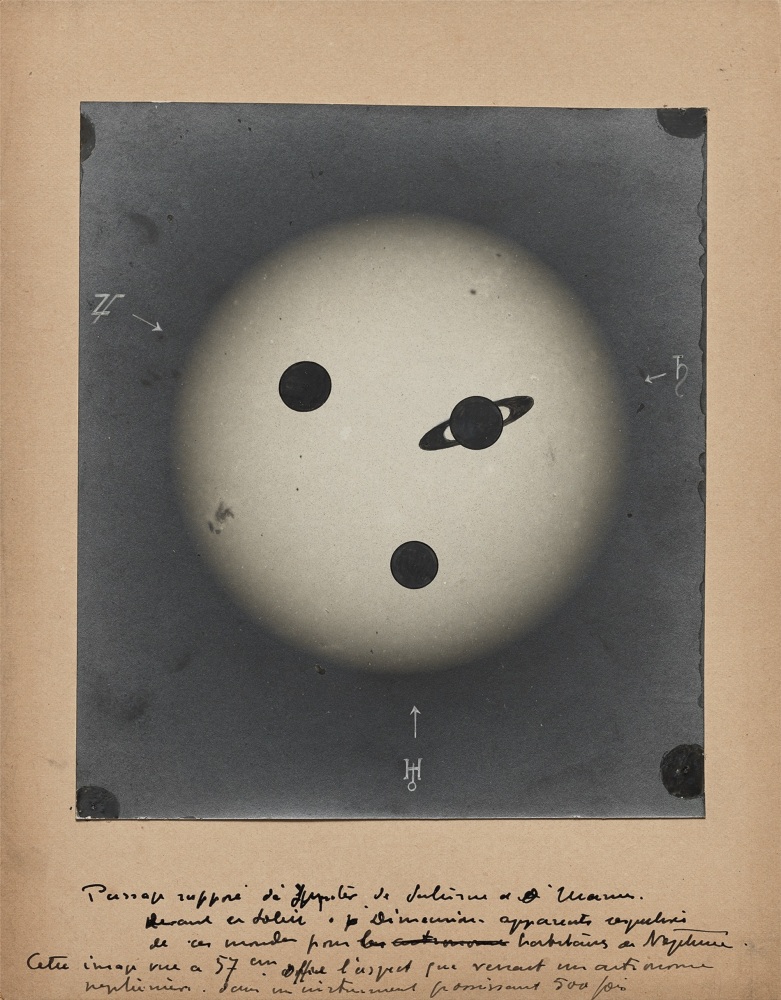
Unknown Photographer
Imagined passage of Jupiter, Saturn, and Uranus in front of the sun, circa 1900
Gelatin silver print with applied pigment
12.8 x 11.3 cm mounted on 18.2 x 14.4 cm card
"Supposed passage of Jupiter, Saturn and Uranus in front of the Sun. The respective apparent dimensions of these worlds for the inhabitants of Neptune. This image seen at 57th [?] offers the aspect that a Neptunian astronomer would see in an instrument magnifying 500 times"
Inquire
Anna Atkins (English, 1799-1871)
"Lycopodium (Ceylon)," circa 1851-1854
Cyanotype photogram
35.1 x 25.0 cm
After Anna Atkins, one of the earliest women photographers, produced British Algae, the first published book printed and illustrated with photography, she turned her love of the photogram toward the production of images for sheer visual pleasure. Her cyanotypes of the 1850s are striking precursors of the expressive photography of twentieth-century and contemporary artists. Fellow botanists frequently gave Atkins specimens from their travels.

Belgian Judiciary Service
The Peltzer Case, skull of M. Bernays as evidence, circa 1882
Carbon print
31.7 x 25.9 cm
At the trial, evidence surrounding the gunshot wound to the head was important in establishing the cause of death and whether it could have been a suicide or an accident.

Julia Margaret Cameron (English, born in India, 1815-1879)
"Circe," Kate Keown, 1865
Albumen print
25.2 x 20.2 cm
Cameron sought to record through the faces of her family and friends the qualities of innocence, wisdom, piety, or passion ascribed to great biblical, historical, and legendary figures. Cameron used a long exposure and shallow depth of field to give that slight sense of animation which merges the young girl, Kate Keown, with the mythic character Circe, seemingly bringing her into the viewer's presence in this fine print.

Giuseppe Enrie (Italian, 1886-1961)
Shroud of Turin, 1931
Gelatin silver print
29.0 x 23.0 cm
In May 1931 the Shroud’s owner, King Victor Emmanuel 3rd of Savoye, agreed to have a new series of photographs made on the occasion of an exhibition of the Shroud held that year. The photographer who would make these photographs was Giuseppe Enrie, a professional photographer. The last time photographs had been taken was in 1898 when Secondo Pia had made the famous series showing that the image on the Shroud was like a photographic negative which then set in motion scientific interest in the Shroud. There had been great advances in photographic technologies since Pia's time, and Enrie was given the opportunity to photograph the complete Shroud in three sections, making a series of life-size close-ups of the face, the back and the shoulders, and the bloodstain on the wrist area of the left arm.

Roger Fenton (English, 1819-1869)
Sebastopol from Cathcart's Hill, Crimea, 1855
Salt print from a collodion negative
22.7 x 35.9 cm
In this nearly abstract composition, Fenton focuses his lens on the middle-ground to show the officers looking out over the harbor at Sebastopol. Fenton masked out the sky before or during the printing process.

John Beasley Greene (American, born in France, 1832-1856)
Venus de Milo on rooftop in Paris, 1852-1853
Waxed paper negative
31.2 x 24.3 cm
Greene's rooftop images of vegetables and the plaster cast of the Venus de Milo were made during his formative period as a student of Gustave Le Gray in Paris. Greene, perhaps in collaboration with Le Gray, carried his statuette of Venus to the roof in order to sharpen his skills in lighting and composition.

Gustave Le Gray (French, 1820-1884)
Ocean, solar effect in the clouds, 1856
Albumen print from a collodion negative
31.0 x 40.4 cm
One in a series of poetic and meditative seascapes that brought Le Gray international acclaim for their technical and artistic achievement, this print demonstrates his mastery of the medium with a tour de force combination of clouds, empty seas and sun. The seascapes Le Gray created between 1856 and 1858 are the works for which he is most celebrated.

NADAR (Gaspard-Félix Tournachon) and Adrien Tournachon
(French, 1820-1910 and 1825-1903)
Pierrot with fruit, 1854-1855
Gelatin coated salt print (vernis-cuir)
28.0 x 20.9 cm
In 1854-1855, Jean-Charles Duburau was asked by Nadar and his brother Adrien to pose for a series of photographs of expressions and comical misadventures of the pantomime character Pierrot. They were intended as publicity for the brothers’ struggling studio. The photographs were an enormous popular success and won the gold medal at the Exposition Universelle of 1855 in Paris. This print was part of the group exhibited at the Exposition Universelle of 1855.

William Henry Fox Talbot or Rev. Calvert Richard Jones
(English, 1800-1877 & Welsh, 1802-1877)
View from a window, rue de la Paix, Paris, 1843-1844
Calotype negative, waxed
10.8 x 8.3 cm
Off of the Place Vendôme in the 2nd arrondissement of Paris, the Rue de la Paix is best known today for its fine shops. In the 19th century, it hosted many small hotels, and through the window of one of these, this view was taken.

William Henry Fox Talbot (English, 1800-1877)
Lacock woodyard through lattice window, circa 1839-1840
Photogenic drawing mousetrap camera negative
4.3 x 3.6 cm
A view through a window of his home was the first subject on which Talbot focused his camera. It is a concept he addressed on a number of occasions during the earliest years of photography. Square mullions were likely in the Lacock workroom windows in the north range of the Tudor courtyard, facing out into the woodyard. The woodyard is the only place that could have been viewed from the room from which this image was taken. According to Roger Watson, former Curator of the Fox Talbot Museum, these types of windows are no longer extant, but they certainly may have been there in the 1840s. It is not clear if they are glazed windows or bars allowing ventilation. The rooms along this range were all used for storage, tack for the horses, groundskeepers tools etc. They were generally small dark rooms illuminated by a window facing the courtyard and a window facing the woodyard. No print from this negative is recorded.

Félix Teynard (French, 1817-1892)
"Égypte / Djïzeh (Necropole de Memphis) / Pyramide de Chéops (Grande Pyramide)," 1851-1852
Salt print, 1853-1854, from a paper negative
24.5 x 30.7 cm
Félix Teynard was one of the first visitors to Egypt to record its monuments and landscape in photographs. A civil engineer from Grenoble, who may have learned the waxed paper negative process from Le Gray, he traveled on an extended voyage to photograph the architecture and landscape of Egypt and Nubia in 1851-1852. Teynard’s 160 images constituted the most complete photographic record to date of the Nile Valley from Cairo to the Second Cataract. These were printed by the Paris firm of Fonteny in 1853-1854 and published by Goupil in 1858.

Unknown Photographer
Imagined passage of Jupiter, Saturn, and Uranus in front of the sun, circa 1900
Gelatin silver print with applied pigment
12.8 x 11.3 cm mounted on 18.2 x 14.4 cm card
"Supposed passage of Jupiter, Saturn and Uranus in front of the Sun. The respective apparent dimensions of these worlds for the inhabitants of Neptune. This image seen at 57th [?] offers the aspect that a Neptunian astronomer would see in an instrument magnifying 500 times"
